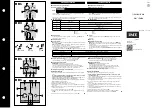
DT3000
Instruction Leaflet
I.B. 17555D
Effective: Date 07/02
Page 5
For more information visit:
www.cutler-hammer.eaton.com
Supersedes I.B. 17555C dated November 1999
Fig. 1-3 Digitrip 3000 Protective Relay with DIP Switches
Shown in Upper Left (Rear View)
By providing 11 different curve shapes the Digitrip 3000
provides greater selective coordination with almost any
existing electromechanical overcurrent relay or power fuse.
(Figure 1-4).
•
Thermal Curves (4 shapes)
- It
- I2t
- I4t
- Flat
•
ANSI Curves (3 shapes per ANSI C37.112)
- Moderately Inverse
- Very Inverse
- Extremely Inverse
•
lEC Curves (4 shapes per IEC 255-3)
- IEC-A (Moderately Inverse)
- IEC-B (Very Inverse)
- IEC-C (Extremely Inverse)
- IEC-D (Definite Time)
The ground element of Digitrip 3000 can have a curve shape
independent of the phase element, providing for a more
versatile ground protection.
A pictorial representation of characteristic curve shapes is
provided on the face of the relay for reference purposes.
All Digitrip 3000 Protective Relays have zone selective
interlocking capabilities for phase and ground fault
protection. Zone selective interlocking is a means by which
two or more coordinated trip devices can communicate to
alter their pre-set tripping modes to provide a faster response
for certain upstream fault conditions. The relay is shipped
with the zone selective interlocking feature disabled by the
use of the two jumpers on the rear mounted terminal strip
TB1 (Figure 1-5).
Digitrip 3000 Protective Relays operating parameters and
troubleshooting information are displayed on the front of the
relay, via the two display windows. This is considered “ON
DEVICE” information. In addition, all relay information can be
transmitted to a remote location via the built-in INCOM
communication system. This type of information is referred to
as “COMMUNICATED INFORMATION”.
Fig. 1-4 Digitrip 3000 Curve Shape Possibilities










































